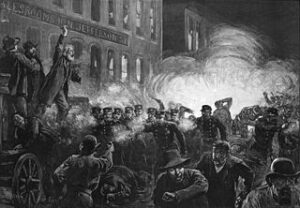This is Faith in Play #22: Individualism, for September 2019.
Quite a few years ago now I was playing a character in an experimental Attorney class in a game largely based on original Advanced Dungeons and Dragons™. I had just successfully defended a player character (an Antipaladin) on a murder and robbery charge, and the player said to me, “Boy, your character must be really lawful.”
I answered, “No, he’s Chaotic Neutral.”

And that illustrates just why it is that the Chaos side of the alignment graph is so badly misunderstood and so poorly handled. My attorney was Chaotic in the best traditions of the American Civil Liberties Union (ACLU): he firmly believed that every person (character) had the right to be and to do whatever he wanted, as long as in doing so he did not unfairly infringe on the right of any other character to do or be what he wanted. Although anarchy can be the consequence of chaos pushed to the extreme, chaos is not about anarchy, but about liberty. It is the alignment expressed in the Bill of Rights, espoused by the Libertarian Party, and represented by Democracy.
And so we continue our examination of the original Advanced Dungeons & Dragons™ alignment system, which began by identifying alignment as the True Religion of the game, then looked at the real meaning of Goodness and Wickedness, and most recently considered Law under the heading of Order. In looking at Law, we stated that it was only incidentally about rules and structures, and more fundamentally about the view that the society was more important than the individual, and thus the society could use the individual in whatever way would best promote the success and continuation of the society.
That logically means that Chaos is its opposite, the view that the individual is more important than society.
The logic which we presented to show that the Lawful view was better works in reverse. In that case, we noted that humans live a mere few decades and then die, while societies, nations, and races last for centuries, sometimes millennia, sometimes longer. The individual thus is a drop in the bucket, and what matters is the bucket, the collective of all individuals, the society. Yet, again citing C. S. Lewis, that gets inverted if we recognize that humans are at least potentially immortal. If life continues after death, then the lives we live far outstrip not merely the life of the nation but the life of the race, the planet, the universe itself. We become more important, and what matters most in the world is not whether the nation thrives but whether individual people become what we ought to be in the eons ahead. All of this exists for us, but not for us collectively, for us individually—for you, for me, for him and her. The nation, society, only exists to facilitate our becoming ourselves.
That doesn’t mean that there are no rules. It means that rules exist solely to create a world in which individuals can thrive.
That, then, is the essence of the chaos alignment. It is not “I can do whatever I want”—that selfishness, as we saw, is Evil. It’s “everything exists for the freedom of individuals”. That is a faith in which many can believe, a principle, a tenet, a doctrine, worthy of support.
And so we have examined the four core beliefs that comprise the sides of the alignment grid: beneficence seeking the greatest good for the greatest number, selfishness seeking the greatest benefit to oneself, structure seeking to promote the continuation of the society, and liberty seeking to promote the freedom of the individual. We still have more to cover, but these are the fundamentals.
Previous article: Villainy.
Next article: Kralc’s Law.
